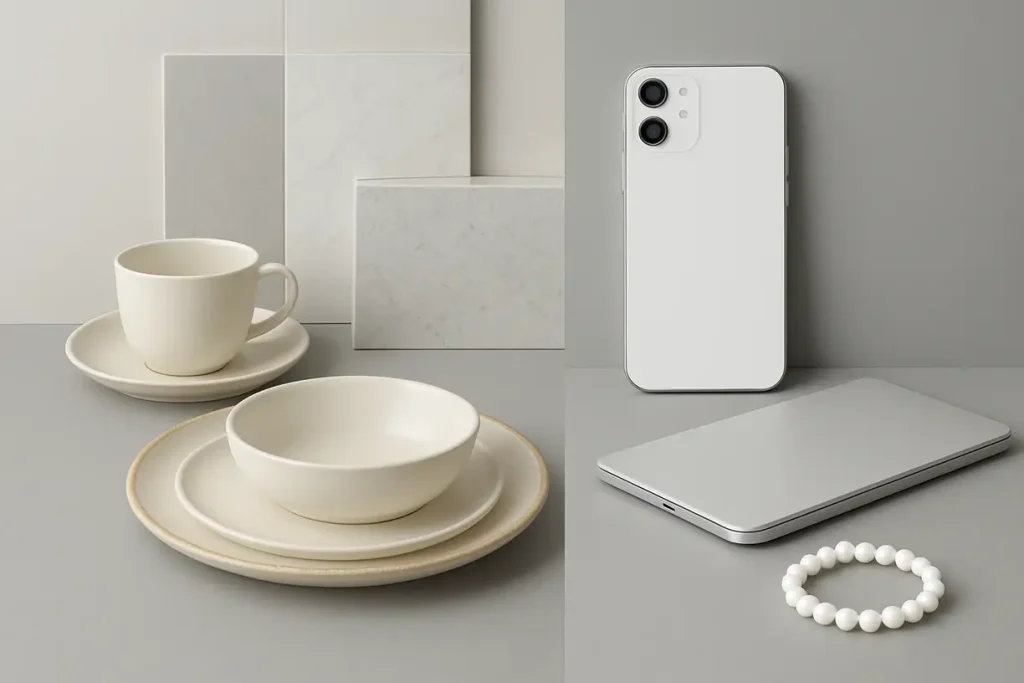In today’s competitive landscape, understanding the forces that shape material choices is essential. One material gaining attention is zirconium silicate, which has been used for various design applications across different industries. However, many purchasing managers may wonder what cultural factors influence the adoption of this material. This article addresses that question, drawing on insights relevant to decision-makers like you. By identifying the cultural and societal factors at play, you’ll gain a clearer perspective on how they impact your choices and those of your customers. Trust that this exploration will provide the knowledge you need to make informed decisions, ultimately enhancing your product offerings and market reach.

This image illustrates the variety of applications of zirconium silicate in modern design contexts.
What Are the Key Cultural Factors Influencing Adoption?
Cultural factors serve as guiding principles for how materials are perceived and adopted in design. At the heart of this discussion is the interplay between regional traditions, aesthetic values, societal trends, and historical influences, all of which shape preferences for materials like zirconium silicate.
First, it’s crucial to define cultural factors as the beliefs, values, and norms shared by a group that inform their choices. In a design context, these factors significantly impact whether a material garners enthusiasm or faces skepticism. Thus, businesses must consider these cultural aspects to gauge market appetite accurately.
Zirconium silicate has gained recognition for its durability and aesthetic appeal, but acceptance varies across different cultures. For instance, societies may prioritize sustainability, while others may emphasize aesthetics or cost. Understanding these nuances is vital for effectively positioning products in diverse markets.
To illustrate this complexity, consider the following factors that influence the adoption of materials in different cultures:
| Cultural Factor | Influence on Material Selection |
|---|---|
| Sustainability Focus | Cultures favoring eco-friendly options may embrace durable materials that offer long lifecycles. |
| Aesthetic Preferences | Regions with rich artistic traditions value visually striking materials that complement their design legacy. |
| Economic Priorities | In economically constrained areas, cost-effectiveness can be the decisive factor over other attributes. |
By recognizing the interplay between culture and material selection, companies can better tailor their offerings to meet local expectations, ultimately leading to greater success in diverse markets.
How Does Regional Culture Affect Material Preferences?
Regional cultures significantly contribute to material preferences in design. Different geographic locations have unique traditions and aesthetics that inform decision-making. Understanding these cultural dynamics allows companies to better align their strategies with consumer expectations.
For instance, in North America, there is a strong emphasis on innovative materials that combine sustainability with functionality. Consumers often seek options that are eco-friendly and durable. This trend drives designers and manufacturers toward materials like zirconium silicate that meet these demands effectively.
In contrast, regions with a deep-rooted connection to tradition, such as parts of Asia, may show a preference for materials that reflect historical craftsmanship. This conservatism can lead to hesitance regarding newer materials, despite their advantages. It’s important for companies to acknowledge these differences when introducing products into different markets.
To better understand the impact of regional culture, consider the following table, which outlines varying preferences for design materials across different locations:
| Region | Material Preference | Key Influences |
|---|---|---|
| North America | Sustainable and functional materials | Innovation, conservation |
| Europe | Aesthetically pleasing, quality-driven | Traditional craftsmanship, heritage |
| Asia | Historical, culturally significant | Respect for tradition, artisanship |
| Middle East | Luxurious finishes | Opulence, cultural heritage |
As seen, preferences for materials can vary widely based on these regional characteristics. This underscores the necessity for businesses to tailor their marketing strategies based on cultural understanding to enhance adoption rates and market success.

This image showcases various cultural symbols representing different design preferences worldwide.
What Role Do Aesthetic Values Play in Adoption Decisions?
Aesthetic values significantly impact the popularity of specific materials in design. When making choices, decision-makers frequently assess how a material aligns with their vision, brand identity, and the emotions they want to evoke in consumers.
Visual appeal stands as a primary driver behind many design applications. Companies aim for their products to captivate and resonate with clients. Zirconium silicate’s natural shine and variety of colors enable designers to create compelling visual narratives. A well-designed product can quickly capture the attention of potential buyers, making it essential for manufacturers to prioritize the material’s aesthetic considerations.
Moreover, the relationship between aesthetics and functionality cannot be underestimated. Aesthetic values extend beyond appearances; they encompass texture, coloring, and the overall emotional response elicited by a material.
Here’s a simple breakdown of how aesthetic values influence adoption:
- Appearance: The visual characteristics of zirconium silicate can play a crucial role in enhancing a product’s overall design.
- Brand Image: Brands that emphasize modernity and elegance might readily adopt materials that mirror these values, making an effort to connect with consumers who share similar ideals.
- Consumer Preferences: Today’s consumers often gravitate toward products that reflect their tastes and preferences, directly impacting market trends.
In essence, adopting materials like zirconium silicate relies not only on their performance but also on how they contribute to the product’s visual story and emotional impact.
How Are Societal Trends Shaping Material Choices?
Societal trends play a pivotal role in material decision-making, particularly as consumer values shift. More than ever, consumers are conscious of environmental issues. This growing trend is driving demand for sustainable, eco-friendly materials.
Incorporating zirconium silicate into products can align with these evolving expectations. The material’s inherent durability translates into a longer lifecycle. This promotes sustainable design practices, which are increasingly important to customers seeking out goods that reflect their values. However, mere usage is not sufficient; brands must communicate their commitment to sustainability clearly and effectively.
Consider current societal trends such as the rising demand for eco-friendly products, the focus on local sourcing, and heightened sustainability awareness. When a company showcases its use of zirconium silicate in a context of ecological responsibility and transparency, it solidifies its market position while building consumer trust.
The following table illustrates how various societal trends influence design materials:
| Trend | Impact on Material Choice |
|---|---|
| Sustainability | Increased preference for durable, eco-friendly options |
| Local Sourcing | Preference for materials that support local economies |
| Minimalism | Demand for simplicity in design and function |
| Personalization | Desire for unique and customizable materials |
This shift creates a ripe opportunity for companies to innovate with zirconium silicate while making their brand’s values clear to customers.
What Impact Do Economic Conditions Have on Adoption?
Economic conditions are critical to material adoption and shape how businesses respond to changing markets. During economic downturns, companies might look for cost-effective materials that deliver solid performance without breaking the bank. Conversely, a thriving economy can encourage increased investments in higher-quality materials, such as zirconium silicate.
The cost-versus-benefit analysis becomes crucial for purchasing managers. Zirconium silicate boasts several advantages in terms of durability and aesthetic appeal, often saving companies money in terms of replacements and maintenance over time.
Economic factors including inflation, market stability, and availability of resources can deeply influence purchasing habits. During periods of uncertainty, firms tend to prioritize budgetary constraints, which can steer them toward more economical alternatives. Businesses that adjust their strategies accordingly can find significant advantages in market positioning.
To illustrate how these economic conditions persistently influence material selections, consider the data below:
| Economic Condition | Material Preference Change | Reasons |
|---|---|---|
| Recession | Shift toward lower-cost materials | Budget constraints |
| Economic Growth | Increased willingness to invest in quality | Desire for innovation, improved performance |
Understanding this correlation is vital for developing strategies around the adoption of new materials like zirconium, ensuring businesses remain competitive regardless of economic fluctuations.
How Does Technology Intersect with Cultural Influences?
Technological advancements significantly affect how materials are adopted and utilized in design. The evolution of zirconium silicate production has opened up new possibilities and applications, allowing designers to experiment with this material in ways that were previously unfeasible.
As technology enhances manufacturing processes, materials become more accessible, customizable, and versatile. This adaptability allows designers the freedom to take risks without fearing substantial financial loss due to product failures.
The intersection of culture and technology warrants attention. In some regions, tech-savvy consumers eagerly seek innovative products, while more traditional markets may resist rapid changes. As a result, companies must assess local appetites for innovation and the extent to which technology influences material preferences.
Moreover, designers need to communicate the advantages offered by modern technology when presenting zirconium silicate. Highlighting its unique applications and ease of integration into various designs can drive greater acceptance among consumers.
Here’s how technology interplays with cultural influences:
- Innovation: Efficient production processes lower costs and increase availability, thus creating more opportunities for adoption.
- Consumer Tech Savvy: A culture that embraces technology often adapts to advancements in materials more quickly, providing a competitive edge for businesses.
- Customization: Technological advancements allow for extensive design customization, making products more appealing to a broader range of consumers.
Awareness of these influences can help entrepreneurs navigate challenges and capitalize on opportunities associated with emerging materials.
What Are the Historical Influences on Design Material Choices?
Historical influences shape material selections in design projects. Over time, certain types of materials, such as zirconium silicate, have experienced fluctuations in popularity based on historical contexts and prevailing design movements.
For example, during the Arts and Crafts Movement, a focus on quality craftsmanship emerged, leading designers to prioritize natural materials over mass-produced alternatives. In contrast, the modernist movement favored clean lines and functional forms, often emphasizing simplicity. Each historical period creates a framework for what is deemed acceptable or desirable in design contexts.
Understanding these influences allows companies to contextualize their products and predict future consumer preferences. If there is a resurgence of minimalism, for instance, materials such as zirconium silicate may gain more interest due to their compatibility with clean, simple designs.
Here’s a table showcasing historical influences on material choices:
| Historical Movement | Material Preference | Key Characteristics |
|---|---|---|
| Arts and Crafts Movement | Natural materials, craftsmanship | Emphasis on handmade, organic products |
| Modernism | Minimal, functional materials | Geometric forms, simplicity |
| Postmodernism | Eclectic mix, bold materials | Break from tradition, expressive design |
By examining historical preferences, businesses can tailor their offerings to align with existing markets, helping to ensure better adoption rates.
How Do Consumer Behaviors Influence Design Materials?
Consumer behaviors profoundly affect material choices in design. Purchasing managers pay close attention to trends and preferences, as these factors directly influence sales and overall market success.
Understanding buyer psychology is essential. Decision-makers should consider how consumer values dictate their purchasing decisions. For example, if consumers prioritize eco-friendliness and usability, manufacturers should clearly highlight these features in zirconium silicate and its applications.
Key points integral to this dynamic include:
- Feedback: Direct input and reviews from customers can shape companies’ future material choices and designs.
- Trends: Shifts in consumer lifestyle, such as increased environmental awareness, directly impact the materials used in design.
- Adaptability: Products that align closely with consumer preferences tend to perform significantly better in competitive markets.
Analyzing consumer behavior fosters more effective marketing strategies around materials like zirconium silicate while enhancing overall brand loyalty and interest.
What Cultural Myths or Misconceptions Affect Adoption?
Cultural myths can present significant barriers to the adoption of advanced materials like zirconium silicate. These misconceptions can stem from a variety of sources, including historical preferences, media portrayals, and general ignorance about newer materials. Misunderstandings regarding a material’s durability, sustainability, or aesthetic qualities can discourage potential users from fully considering its advantages.
Addressing these myths directly is vital for gaining market acceptance. For instance, many industries still cling to the belief that newer materials lack the longevity and reliability of traditional options. This perception can hinder the willingness to experiment with innovative solutions, regardless of clear evidence showing the performance capabilities of zirconium silicate in various applications.
Here’s a breakdown of common misconceptions that can affect market penetration:
- Less Durable: Some believe that modern materials are inherently less resilient compared to time-proven materials. In reality, zirconium silicate demonstrates outstanding durability and can effectively compete with conventional alternatives in terms of lifespan and maintenance.
- Higher Costs: There is a widespread belief that high-performance materials inevitably come with a steep price tag. However, the long-term savings associated with zirconium silicate—due to its durability and reduced maintenance needs—often result in a more economically favorable choice.
By tackling these misunderstandings through education and clear communication, companies can not only increase awareness but also foster greater acceptance among potential users. Addressing these cultural myths, therefore, becomes crucial for expanding the market for innovative materials in design and production contexts.m silicate.
How Can Companies Use Cultural Insights for Better Adoption?
Utilizing cultural insights effectively is essential for companies aiming to increase the adoption of zirconium silicate. Understanding target markets allows businesses to create relevant, resonant marketing strategies that cater to consumer needs.
Conducting thorough research into local cultures, preferences, and values aids in tailoring messages for better reach and engagement. By creating targeted campaigns that highlight the benefits of zirconium silicate, companies can effectively communicate their unique value propositions instead of relying on generic marketing strategies.
Here are ways to leverage cultural insights for effective adoption:
- Identify Target Markets: Understanding different cultural contexts helps businesses better connect with their audience.
- Tailor Messaging: Craft marketing messages that speak directly to the cultural values and needs of your potential consumers.
- Build Relationships: Foster connections with local stakeholders and communities to deepen the brand’s foothold in the market.
Implementing these strategies can cultivate trust among the target audience while boosting adoption rates and building a reputable brand.
Conclusion
This article provides insightful perspectives on the cultural factors that drive the adoption of zirconium silicate in design. We have explored how regional influences, aesthetic values, societal shifts, and historical contexts contribute to material selection and its implications for businesses. A key takeaway is that awareness of cultural dynamics can enhance your decision-making process. By understanding these elements, you can effectively promote the sustainable advantages and unique properties of zirconium silicate to a diverse range of customers. For tailored solutions and expert guidance in navigating these dynamics, reach out to Global Industry today. Your partnership with us can lead to innovative opportunities and strengthen your market position.

This image represents various marketing strategies that incorporate cultural insights for effective product promotion.
FAQ Section
Q1: What is zirconium silicate and its benefits?
Zirconium silicate is a naturally occurring mineral that has gained popularity in various industries due to its remarkable durability and aesthetic versatility. Its primary benefits include high thermal stability, resistance to wear and corrosion, and suitability for applications ranging from ceramics to advanced coatings. This makes it an appealing choice for designers and manufacturers aiming for longevity and performance in their products.
Q2: How do cultural factors influence design materials?
Cultural factors significantly shape consumer preferences for materials based on regional traditions, aesthetic values, and societal norms. For instance, some cultures prioritize eco-friendliness and sustainability, which can increase interest in advanced materials like zirconium silicate. Understanding these cultural dynamics helps businesses tailor their products and marketing strategies to resonate better with target audiences in various markets.
Q3: What are the economic implications of using zirconium silicate?
Using zirconium silicate can have several economic advantages. Although the initial investment may be higher compared to conventional materials, its durability and low maintenance requirements make it cost-effective in the long run. Companies can save on replacement and repair costs, leading to reduced overall expenditure. This financial efficiency appeals particularly to businesses looking to optimize their resources while maintaining high-quality standards.
Q4: Can historical trends predict future material preferences?
Yes, examining historical trends can provide valuable insights into evolving consumer preferences for materials. By analyzing past design movements and the materials that gained prominence during those times, businesses can identify patterns that may re-emerge or adapt in modern contexts. Keeping an eye on these trends can aid in anticipating market demands, allowing companies to stay ahead of their competition.
Q5: How can companies educate consumers about zirconium silicate?
Companies can effectively educate consumers about zirconium silicate by providing comprehensive information through various channels. This can include informative content on websites, engaging workshops, webinars, and detailed product descriptions that highlight its properties and applications. Additionally, leveraging social media and influencer partnerships can help spread awareness and showcase the material’s unique advantages in relatable contexts.
